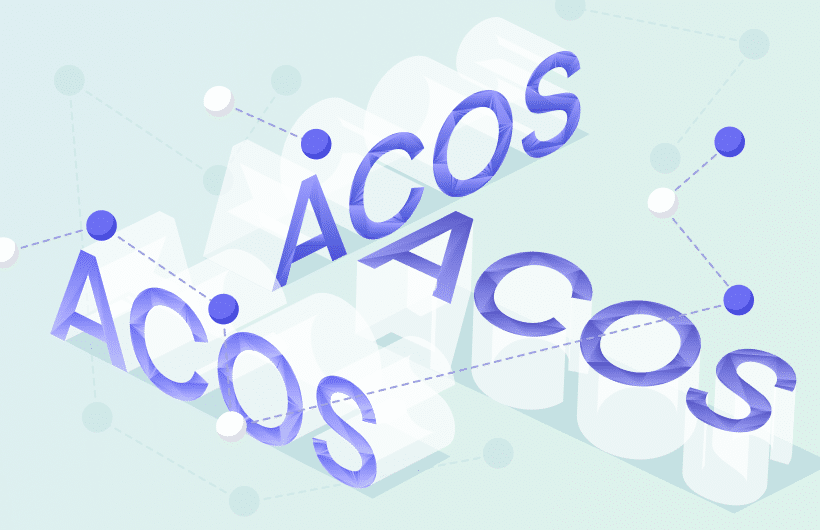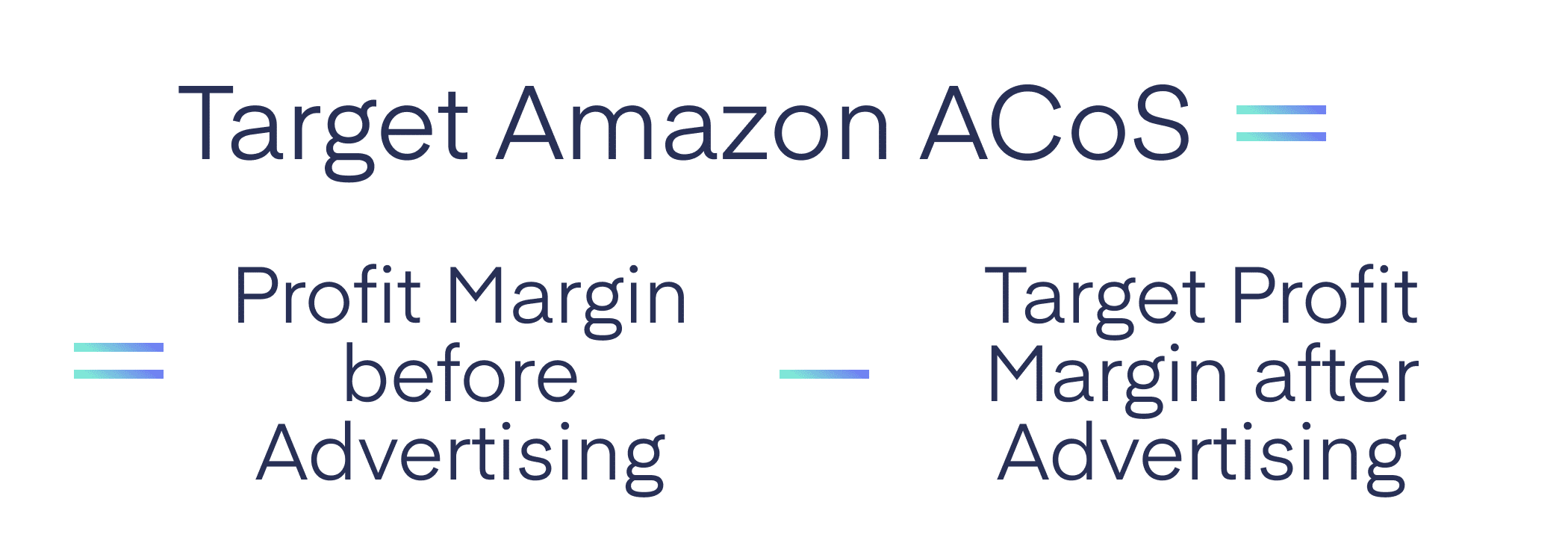
Find out how our team managed to reduce ACoS from 39,9% to 28,81% for a home decor brand!


What is a good ACoS on Amazon, how can a business calculate it and be sure that it is profitable? This is our today’s topic. Let’s get started!
For a business that sells its products on the Amazon platform, understanding and measuring how well your Amazon Sponsored Products campaigns are working is critical. This is why we need ACoS.
Advertising cost of sales is a percentage of unit sales spent on advertising. This is one of the most important concepts in the world of PPC because it gives sellers information about how effective their ad campaigns are, whether they are profitable or not, and what maximum ACoS is required for each product separately.
Amazon ACoS formula looks as follows:

It is easily determined by dividing the ad spend by the number of sales. For instance, an ad campaign generated $300 in sales and cost $84. $84 divided by 300 = 28%. It means that the cost of an ad that brings $1 equals $0.28.
The break-even advertising cost is the point where the advertising cost is equal to the profit margin. A question that can be answered here is, “At what ACoS does a seller make zero profit and zero loss?”.
It’s crucial to promote only one product in each ad. If a seller advertises a group of products it is really hard to calculate the profit.

For instance, if a book’s selling price is $20, the Amazon fee is $3, and the cost of goods sold is $6. Thus, the seller’s profit is $11 before ad spend. If a seller spends that profit for ads, the formula we need to calculate the break-even advertising cost of sales is as follows: $11/$20 = 55%. The breakeven ACoS, in this case, is 55%.
Target ACoS on Amazon
Another important metric that all Amazon sellers need to know is Target ACoS. If a seller really wanted to generate revenue on Amazon, they would not spend all the pre-advertising income to push sales. So, a Target ACoS is what a seller spends, meaning that the profit margin is what has not been spent. If the break-even ACoS is 55%, the TACoS is 40%, and the profit margin is 15%.
The following formula calculates Amazon TACoS:

To figure out the perfect Amazon PPC ACoS, a seller must first find their ideal profit margin and work backward. For example, the average ACoS for most brands is between 15-30%. But it differs from company to company, depending on product offering and marketing strategy.
How to Calculate Amazon Profit Margin?
The result of subtracting all expenses from the selling price is the profit margin. Production costs, shipping costs, executive salaries, storage costs, Amazon fees, etc., can all be related. To measure the profit margin of an item, sellers should understand the cost of the product and use that knowledge to plan their strategy.
The profit margin is the difference in revenue from sales and the cost of doing business. Businesses with a high revenue margin have a gain that outweighs the cost of doing their business. The profit-to-sales ratio is closely related to the idea of the profit being divided among sales. This will be synonymous with your profit being converted into a percentage.

Why is ACoS Important?
Advertising cost of sales helps Amazon sellers determine the success of advertising campaigns, the necessary expenses to generate profit, and their returns. At first it is essential to decide on the targeted PPC ACoS for a detailed analysis of the seller’s current performance. This requires an estimate of the product’s cost (and break-even points described above).
ACoS is a metric related to advertising effectiveness, so it is an important factor for Amazon because it stands for an indicator of your ad campaign success. It is worth remembering that advertising cost of sales alone is not a precise measure of profitability. Sellers must take into account the total cost of the product they advertise.
The aim of a brand or a seller on Amazon should be to increase profit over time, growing the business. Thus, sellers should define their ad spend and the net profit margin when targeting a specific net profit margin.
Having all goals figured out and each step planned is the only way to be ready for challenges while running a store on Amazon. When working with an advertising campaign objective, such as launch and promotion of a new product, the goal is to generate awareness, sales, and/or ROI.
The more clearly and concisely you express your goals, the easier it is to decide the products to include in your campaigns, structuring them and measuring outcomes.
Choosing the Right Amazon ACoS Based on Your Goals
Your Amazon ACoS strategy is fully dependent on your PPC campaign goals. So be clear on what you want to achieve, and then you can concentrate on either break-even ACoS or target ACoS.
If you’re about to launch a new product to receive more feedback and sales asap and to boost your organic rankings, you might be focusing on making the most of your sales while breaking even. That being said, you should aim for break-even Amazon ACoS.
Maximizing impressions will raise your brand awareness and give you a competitive edge. With that in mind, you might want to consider focusing your efforts on maximizing the number of impressions while breaking even. So you should focus on the break-even Amazon ACoS.
It’s important to always keep revenues as a central focus for established products. To get the necessary profit margin you want to aim for target Amazon ACoS.
Total ACoS (TACoS) as an Additional Metric
Your ACoS for Amazon PPC only takes into account the sales you made via ads. Thus, ACoS may not be the most reliable metric for you to use if you are trying to figure out how to best scale your business, launch a new product or try to reach greater keyword ranking.
It’s useful to consider your TACoS before trying to accomplish any of the above-mentioned purposes. TACoS includes both your ad sales and your organic sales to give you a clear and detailed picture of your ad spend.
You can also use TACoS in order to:
Amazon average ACoS is an ideal point of reference. The average ACoS is about 30%, but it is going to modify depending on your strategy and goal. Typically, you should aim for an ACoS of around 15-20%. To maximize your bottom line, the cost of your products has to be higher than your ad spend.
In 2019, the average ACoS on Amazon (for Sponsored Product Ad’s ACoS to be more precise) was around 34% for Ad Badger.
A lower ACoS is a positive indicator of a successful PPC campaign. For this reason, you should strive to decrease your ACoS to increase profits. On the other hand, it depends on what your strategy is to sell a product and your profit margin.
While a low ACoS can be profitable for a business, a high ACoS can ensure a solid position on the market by increasing business visibility, dominating the niche, and resulting in long-term revenue.
Amazon ACoS vs RoAS vs MACoS
Comparing primary Amazon metrics will help understand them better. So, how do ACoS, RoAS, and MACoS differ?
Amazon PPC advertising cost of sales gives you an idea of your advertising costs that earned you an income from attributed sales. RoAS allows you to estimate how much money or cash you will make for every dollar you spend on advertising. MACoS monitors Sponsored Ads outlays and the respective ASINs total (PPC + organic) sales.

How To Use Amazon ACoS On Seller Central
To find ACoS, head to the right-hand column of the Seller Central dashboard:

It’s vital to regularly work on the PPC ACoS to ensure that everything goes according to the plan. Calculate break-evens and TACoS to make sure that ACoS is good.
Several key metrics drive advertising cost of sales on Amazon.

Ad Spend or Ad Costs (ASP)
The amount of money spent on specific ads within a particular campaign is known as Ad Spend. IT usually includes online, broadcast, print, outdoor advertising, and direct mail.
Cost-per-Click (CPC)
A statistical correlation can be found between cost per click and ad spend: if CPC rises, ad spend grows (and vice versa). Increasing the bid value or adapting a bidding strategy may affect CPC, but, sellers often have little control over those rates.
Click-Through-Rate (CTR)
CTR only affects ACoS if conversion rates change. To enhance CTR, a seller has to ensure quality (organic) traffic that will push conversion and exclude the possibility of higher advertising cost of sales.
To calculate the CTR, use the formula below.

Conversion Rate (CVR)
No matter how appropriate your Ad may be for your business, it will only generate leads if the customers landing on your product page are interested in your product. Seller’s job is to persuade visitors to their page that their product is the best, and they should buy it.
The following formula can calculate the conversion rate:

CTR is influencing ad spend and ad revenue equally. It means, sales always grow together with ad spend.
Bid
When a seller’s bid for a specific keyword wins, the listing surfaces at the top of of the search results page. Make use of auto-bidding tools to manage your bids for the most important keywords, ensuring you never miss an impression.
Impressions
High impressions rate can get at the product being located in a popular category on Amazon. Amazon may show a particular product’s ad day in and day out, but sellers may not have any genuine interest in that product, and then the impressions on Amazon will become low.
Clicks
If a customer finds the ad related to the search they make, they will click on it.
Orders
There is a high chance of a buyer purchasing a product in the time frame where the ad was displayed.
Ad Revenue
Ad revenue is how much businesses earn while displaying paid advertisements.
RoAS stands for the return on ad spend. With its help, sellers can calculate the amount of income (or loss) from each invested dollar and evaluate the productivity of a particular ad campaign or even a keyword.
There’s no good or bad Amazon PPC ACoS. You may have heard the phrase “lower your advertising cost of sales,” but it is also not 100% true. It all depends on your marketing strategy and goals. When a business or individual implements a strategy for a “good ACoS” or a low ACoS, it generally implies a strategy that maximizes their company’s profitability.
We hope this content was helpful. If you have any remaining questions, the Profit Whales team will gladly help you answer them during an audit or an individual consultation. So, let’s connect!
Comments
Leave a Reply